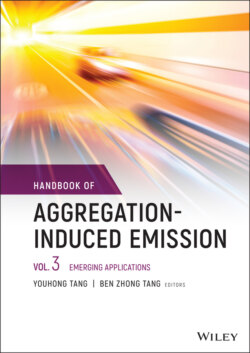Читать книгу Handbook of Aggregation-Induced Emission, Volume 3 - Группа авторов - Страница 34
2.7 Liquid Crystals
ОглавлениеCPL‐active liquid crystal (LC) systems based on AIEgens were also investigated. The helical orientation of the LC molecules appears to be critical for the CPL performance. Both helical stacking of chiral AIEgens and doping achiral AIEgens in chiral nematic LCs can generate CPL.
In 2015, Lu et al. prepared a novel AIE‐active chiral LC molecule 85 by introducing two cholesterol pendants into a TPE unit with long alkyl chains (Figure 2.29) [65]. With a flexible molecular structure, molecule 85 formed a cholesteric LC and exhibited temperature‐dependent chiroptical properties. The resulting LC showed a prominent CPL performance with glum of +2.5 × 10−2 (483 nm) at 20 °C, and declined to +7.5 × 10−3 (480 nm) at 40–50 °C. Above 60 °C, the mixture was almost CPL‐inactive. The temperature‐sensitive CPL was consistent with the trend of CD signals. The fact that the CD and CPL signals changed with temperature was presumably due to the variations of the helical pitch of the cholesteric phase. Polarizing optical microscopy images further proved the hypothesis. In 2019, Yang et al. prepared two LC molecules by modifying a TPE unit with four cholesteric‐derived side chains [66]. Through ordered columnar self‐assembly, these molecules formed a liquid crystalline mesophase and generate CPL with glum up to +8.8 × 10−2 (491 nm).
Figure 2.29 (a) Molecular structure of 85 and corresponding glum. (b) Schematic illustration of temperature‐dependent CPL. (c–g) Polarizing optical microscopy images of 85 at different temperatures: (c) 20 °C, (d) 50 °C, (e) 60 °C, (f) 75 °C, and (g) 90 °C, scale bar: 200 μm. (h–k) CPL spectra of 85 at different temperatures: (h) 20 °C, (i) 40 °C, (j) 50 °C, and (k) 60 °C. (l) glum factor vs. wavelength plot at different temperature.
Source: Reproduced with permission [65]. Copyright 2015, The Royal Society of Chemistry.
In 2016, Tang et al. reported a CPL‐active system with achiral TPE‐derived molecule 86 (Figure 2.30) doped in a chiral nematic liquid crystal (N*LC) [67]. The resulting LC favored the fabrication of a display with |glum| as high as 0.4.
Figure 2.30 Molecular structure of achiral AIEgen 86 [66].
In 2018, Cheng et al. prepared an achiral emissive nematic liquid crystal by doping BINOL‐derived AIEgen enantiomers R/S‐87 into a common achiral nematic liquid crystal (N‐LC E7) (Figure 2.31) [68]. The products exhibited AICPL centered at 536 nm with high |glum| up to 0.41. Later in 2019, the same group reported a subsequent work on a three‐component chiral nematic liquid crystal system (Figure 2.32) [69]. As shown in Figure 2.32c, an achiral nematic liquid crystal was used as the host, and then doped with chiral BINOL‐derived dopant R/S‐88 and achiral AIEgens 89–92. The resulting chiral nematic liquid crystals showed strong CPL with |glum| in the range of 0.97–1.42 (505–610 nm). In 2019, Duan et al. also reported a doped chiral LC system with |glum| up to 0.27 [70]. Recently, Cheng et al. prepared two D–A type chiral AIEgens and prepared chiral nematic liquid crystals with strong CPL around 550 nm with glum of ±0.37 [71].
Figure 2.31 (a) Molecular structures of R‐87 and S‐87. (b) CPL spectra of N*‐LC with various weight percent of R‐87 and S‐87. (c) Schematic representation of the process of chiral induction.
Source: Reproduced with permission [68]. Copyright 2018, Wiley‐VCH.
Figure 2.32 (a) Molecular structures of chiral dopant enantiomers R‐88 and S‐88. (b) Molecular structures of AIE‐active dyes 89–92. (c) Schematic presentation of AIE‐N*‐LC assembly.
Source: Reproduced with permission [69]. Copyright 2019, The Royal Society of Chemistry.
